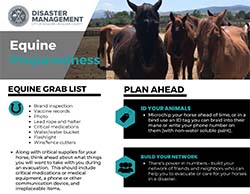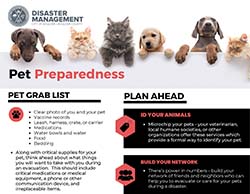Pets and Animals
Household Pets
When preparing household pets for disasters, consider the following:
- Have a plan for how you’ll evacuate your pets.
- Make sure you have necessary leashes, collars, harnesses, crates, or other transportation devices that keep them safe.
- Remember, pets get stressed just like we do. Your pet may behave differently during disaster – so make sure to take extra precautions. If your pet does not normally run away, hide, bite, etc. remember that their typical behavior may change while they’re under the stress of a disaster.
Pet Emergency Kit
- Leash and Collar/Harness
- Crate
- Food
- Water
- Proof of ownership
- Clear photo of animal
- Medical records
- Veterinarian contact information


